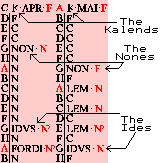Short
History of the Solar Order
At
present we have the so called
Gregorian
calendar
that was fixed on the seasons in 1582 with a
weekorder having a rhythm of its own. This
contrasting of unnatural weeks with natural
dates is what may be called
the
cultural consciousness of the solar
order;
a strategy of time-management agreed upon
democratically: partly religious (science is
not that sure), partly commercial.
In
contrast with this cultivated time we have
the
old concepts of the Julian
calendar
(that was abandoned in two phases: first its
public weekorder in AD 321 later its
imprecise leaping in 1582.) and the unknown
but recently discovered
'Cakra'-calendar
of the original vedic order as described in
the third Canto of the Srimad
Bhagavatam
(the bible of Krishna's life and times).
 These
two old calendars are about the same: they
transpose the lunar order of 48 phases on the
solar year as measured by the seasons (the
Tropical Year) making a year of 24
fifteen-day periods or fortnights with extra
inserted (season-) days to keep the calendar
aligned with the sun. The old Romans spoke of
Ides, Kalends and Nones (to the phases of the
moon) and the vedic culture speaks of panca
dasa's, fifteen day periods that are 'dark'
or 'light', also inspired by the moonphases.
Together with the respect for the
moon(calendar) itself this division of the
solar year in contrast makes for what can be
called a natural
consciousness of solar
order.
These
two old calendars are about the same: they
transpose the lunar order of 48 phases on the
solar year as measured by the seasons (the
Tropical Year) making a year of 24
fifteen-day periods or fortnights with extra
inserted (season-) days to keep the calendar
aligned with the sun. The old Romans spoke of
Ides, Kalends and Nones (to the phases of the
moon) and the vedic culture speaks of panca
dasa's, fifteen day periods that are 'dark'
or 'light', also inspired by the moonphases.
Together with the respect for the
moon(calendar) itself this division of the
solar year in contrast makes for what can be
called a natural
consciousness of solar
order.
The
same way as with the calendar one can also
look at the clock: we have the consciousness
derived from the
relative of political standardtime
with
its zones, mean time and summertime schedules
as set in the 20th century and we
have
the classical old timing to the absolute of
the sun
that dictated the timeconsiousness of our
ancient societies and cultures of sundials
and waterclocks for thousands of
years.
Purpose
of the Solar Order
The
basic purpose of these pages on the solar
order is to
contrast the cultural relative, arbitrary and
thus uncertain consciousness of standardtime
with the natural absolute and irrefutable or
certain of the consciousness of natural time
in order
to gain control over our modern time and its
chaos of cultivation and conditioning,
politics and psychology.
The
Science
Next
two tables are discussed which serve the
implementation of these ideas along the lines
of astronomical observation.
1)
The
Equation of
Time:
this table is given to correct a reference
clock to the position of the sun. This in
order to be able to compare the normal
clock with the classical concept of solar
time, just like having a thermometer for
inside and outside temperatures. With such
a reference clock one can manage that part
of ones life that can be run outside the
normal conditioning of
standardtime.
2)
The
Cakra
Calendar.
First a lists of advantages is given in
using it and after that the actual
division is offered that shows the way the
old roman calendar before divided our
solar year.
The two
tables are together with the data of the
Lunar
Order
combined into one calendar called the
Full
Calendar of
Order.






